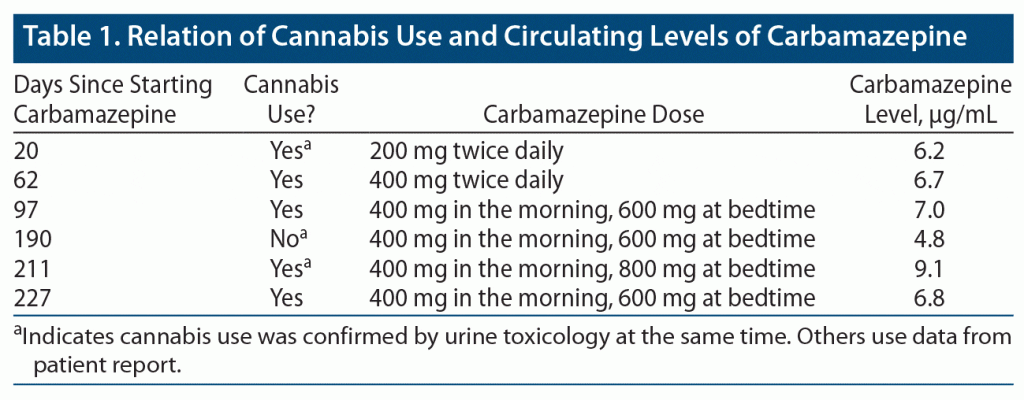
J Clin Psychiatry 2021;82(3):20cr13777
To cite: Ridout KK, Young-Wolff KC, Ridout SJ. A change in blood carbamazepine levels associated with cannabis use: implications for clinical practice. J Clin Psychiatry. 2021;82(3):20cr13777.
To share: https://doi.org/10.4088/JCP.20cr13777
© Copyright 2021 Physicians Postgraduate Press, Inc.
aDepartment of Psychiatry, Kaiser Permanente, Santa Rosa, California
bDivision of Research, Kaiser Permanente Northern California, Oakland, California
*Corresponding author: Kathryn K. Ridout, MD, PhD, 401 Bicentennial Rd, Santa Rosa, CA 95403 ([email protected]).
With state legalization, cannabis use is rising in the United States.1 Cannabis use is common by individuals with psychiatric disorders and can be associated with alterations in mood and energy and other psychiatrically related symptoms.2 Despite this rise in cannabis use, much is unknown about its pharmacokinetics as related to psychiatric medications. The cannabinoids Δ-tetrahydrocannabinol (THC), cannabidiol (CBD), and cannabinol (CBN) are prominent cannabis components. These cannabinoids are metabolized by cytochrome P450 (CYP)3A4 (THC, CBD, and CBN), CYP2C9 (THC and CBN), and CYP2C19 (CBD)3 and can inhibit CYP2C9, CYP1A1/2, CYP1B1 (THC, CBD, and CBN), CYP2D6, CYP2C19, CYP2B6, CYP2J2 (THC and CBD), and CYP3A4/5 (CBD).4,5
While many psychiatric medications are metabolized by these same enzymes, there is a paucity of data regarding interactions between psychiatric drugs and cannabis. Carbamazepine is an anticonvulsant medication commonly used for psychiatric disorders and approved by the US Food and Drug Administration for bipolar disorder treatment.6 Carbamazepine is highly metabolized by CYP3A4 with minor metabolism by CYP2C8, 3A5, and 2B6.7 Recently, carbamazepine was highlighted as a medication with a narrow therapeutic index, suggesting close monitoring when coadministered with cannabinoids.8 Here, we describe a case of concurrent use and likely interaction between cannabis and carbamazepine in a patient with bipolar disorder diagnosed using Diagnostic and Statistical Manual of Mental Disorders, Fifth Edition, criteria.
Case Report
A 37-year-old male with a history of bipolar disorder and long-standing cannabis use presented with elevated mood, grandiosity, increased goal-directed activity, decreased need for sleep, talkativeness, flight of ideas, distractibility, and risk-taking after stopping olanzapine for approximately 2 months. Carbamazepine 200 mg twice daily and olanzapine 5 mg at bedtime were started. Temazepam 15 mg was added to help with sleep after 1 week. After 2 weeks, carbamazepine was increased to 400 mg twice daily, and blood levels were therapeutic at 6.7 μg/mL (Table 1). During treatment, olanzapine was titrated up to 20 mg and carbamazepine to 400 mg in the morning and 600 mg at bedtime until symptoms of mania improved, then temazepam was stopped and olanzapine tapered to 5 mg over the next few months. During this time, the patient reported smoking cannabis 1–2 joints daily, and his carbamazepine levels were 6.7–7.0 μg/mL.
The patient stopped cannabis use, which was confirmed by urine toxicology screen 6 weeks after cessation. At this time, carbamazepine levels were 4.8 μg/mL. The patient denied other medication, diet, or supplement changes. Carbamazepine was increased to 400 mg in the morning and 800 mg at bedtime. The patient restarted cannabis 1 joint daily, confirmed by urine toxicology screening 2 weeks after restarting. At this time, the carbamazepine level was noted to be 9.1 μg/mL. With a decrease in the carbamazepine dose by 200 mg, the patient’s carbamazepine level returned to 6.8 μg/mL.
Discussion
This case illustrates a likely interaction between cannabis and carbamazepine. The patient’s carbamazepine level dropped with self-reported and laboratory confirmed cannabis cessation. CBD inhibits CYP3A4/5, and both THC and CBD inhibit CYP2B63,5; CYP3A4 is the major metabolic pathway for carbamazepine, and CYP3A5 and CYP2B6 are 2 of the 3 minor metabolic pathways.7 As such, stopping cannabis use may have led to the carbamazepine level reduction by increasing CYP activity. This is highlighted by the clinical observation that the patient’s blood carbamazepine level was 4.8 μg/mL when not smoking cannabis and 6.8 μg/mL when smoking cannabis on the same carbamazepine dose. These results suggest the need for increased screening regarding cannabis use with carbamazepine and other medications and further research regarding potential drug-cannabis interactions. Other factors impacting cannabinoids and metabolism, including CYP polymorphisms9 and routes of cannabis administration,3 warrant further investigation.
Published online: May 11, 2021.
Potential conflicts of interest: The authors report no financial or other relationship relevant to the subject of this report.
Funding/support: This work received internal grant funding from Kaiser Permanente Northern California’s Division of Research. Dr K. Ridout’s time was supported by The Permanente Medical Group’s Physician Researcher Program.
Role of the sponsor: The supporters had no role in the design, analysis, interpretation, or publication of this study.
Patient consent: Consent was received from the patient to publish the case report, and information has been de-identified to protect anonymity.
References (9)

- Hasin DS, Sarvet AL, Cerdá M, et al. US adult illicit cannabis use, cannabis use disorder, and medical marijuana laws: 1991–1992 to 2012–2013. JAMA Psychiatry. 2017;74(6):579–588. PubMed CrossRef
- Dutra LM, Parish WJ, Gourdet CK, et al. Medical cannabis legalization and state-level prevalence of serious mental illness in the National Survey on Drug Use and Health (NSDUH) 2008–2015. Int Rev Psychiatry. 2018;30(3):203–215. PubMed CrossRef
- Stout SM, Cimino NM. Exogenous cannabinoids as substrates, inhibitors, and inducers of human drug metabolizing enzymes: a systematic review. Drug Metab Rev. 2014;46(1):86–95. PubMed CrossRef
- Yamaori S, Ebisawa J, Okushima Y, et al. Potent inhibition of human cytochrome P450 3A isoforms by cannabidiol: role of phenolic hydroxyl groups in the resorcinol moiety. Life Sci. 2011;88(15–16):730–736. PubMed CrossRef
- Qian Y, Gurley BJ, Markowitz JS. The potential for pharmacokinetic interactions between cannabis products and conventional medications. J Clin Psychopharmacol. 2019;39(5):462–471. PubMed CrossRef
- Butler M, Urosevic S, Desai P, et al. Treatment for Bipolar Disorder in Adults: A Systematic Review. Comparative Effectiveness Review, No 208. 2018. Accessed December 30, 2020. https://ncbi.nlm.nih.gov/sites/books/NBK532193/table/ch2.tab1/
- Pearce RE, Lu W, Wang Y, et al. Pathways of carbamazepine bioactivation in vitro, 3: the role of human cytochrome P450 enzymes in the formation of 2,3-dihydroxycarbamazepine. Drug Metab Dispos. 2008;36(8):1637–1649. PubMed CrossRef
- Kocis PT, Vrana KE. Delta-9-tetrahydrocannabinol and cannabidiol drug-drug interactions. Medical Cannabis and Cannabinoids. 2020;3(1):61–73. CrossRef
- Puranik YG, Birnbaum AK, Marino SE, et al. Association of carbamazepine major metabolism and transport pathway gene polymorphisms and pharmacokinetics in patients with epilepsy. Pharmacogenomics. 2013;14(1):35–45. PubMed CrossRef
This PDF is free for all visitors!





